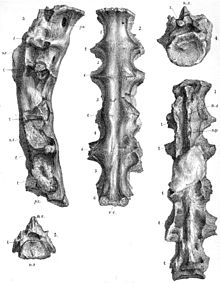Ornithodesmus
|
Ornithodesmus Temporal range: Early Cretaceous, 125 Ma |
|
|---|---|
 |
|
| Illustration of the sacrum in multiple views | |
| Scientific classification | |
| Kingdom: | Animalia |
| Phylum: | Chordata |
| Class: | Reptilia |
| Clade: | Dinosauria |
| Order: | Saurischia |
| Suborder: | Theropoda |
| Family: | †Dromaeosauridae |
| Genus: |
†Ornithodesmus Seeley, 1887 |
| Species: | †O. cluniculus |
| Binomial name | |
|
Ornithodesmus cluniculus Seeley, 1887 |
|
Ornithodesmus (meaning "bird link") is a genus of small, dromaeosaurid dinosaur from the Isle of Wight in England, dating to about 125 million years ago. The name was originally assigned to a bird-like sacrum (a series of vertebrae fused to the hip bones), initially believed to come from a bird and subsequently identified as a pterosaur. More complete pterosaur remains were later assigned to Ornithodesmus, until recently a detailed analysis determined that the original specimen in fact came from a small theropod, specifically a dromaeosaur. All pterosaurian material previously assigned to this genus has been renamed Istiodactylus.
As it is only known from isolated vertebrae, little is known about the appearance of Ornithodesmus. The neural spines of the vertebrae are fused and form a blade over the 9.6 centimetres long sacrum, which is slightly arched. The bases of the neural spines form a lateral platform, and the first two vertebrae of the sequence have deep hollow cavities, which formed space for air sacs.
Based on its apparent identity as a dromaeosaur, it was probably carnivorous, and likely measured about 1.8 meters (5.9 feet) long in life. Dromaeosaur teeth probably belonging to a velociraptorine are known from the same formation, but are too large to have belonged to Ornithodesmus; rather, these must have come from a theropod closer in size to the giant Utahraptor.
Ornithodesmus cluniculus was first described by Harry Govier Seeley in 1887, based on a set of six fused vertebrae from the hip (sacrum), specimen number BMNH R187, found by William D. Fox in the Wessex Formation of Brook Bay. Seeley thought the bones came from a primitive bird, and gave it a name meaning "bird link", from Greek ὄρνις (ornis), "bird", en δεσμός (desmos), "link". The specific name cluniculus means "little buttock" in Latin, a reference to the small thighs indicated by the size of the specimen.
...
Wikipedia
